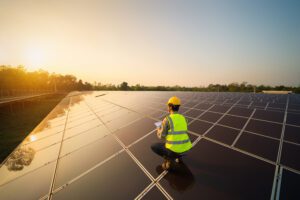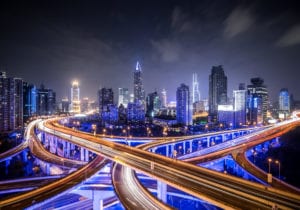When the Inflation Reduction Act (IRA) was signed into law in August, it was widely — and correctly — hailed as a game-changer in the United States’ pursuit of decarbonization. The IRA has been a huge storyline in the media and in the industries it impacts.
I’d like to offer a small corrective here: The IRA is certainly a big deal, but let’s not overlook the IRA’s older — and 3x bigger — sister: the Infrastructure Investment and Jobs Act (IIJA). Even though it passed over a year ago, there are still many questions about how this funding makes its way into actual projects.
I was fortunate enough to connect with three people who have been tracking this legislation from the get-go. They convened a panel at Innovation Summit North America to share their insights: Jeannie Salo, VP of Government Relations, Schneider Electric™; Paula Glover, President, Alliance to Save Energy; and Rochelle Mallett, Managing Principal, Husch Blackwell Strategies.
While listening to this conversation among experts ranging from policy wonks to private-sector players, I took notes on three ways that public and private sectors can get the most out of IIJA funding. Here they are for the benefit of us all.
1. Smarter infrastructure is digital and electric infrastructure.
As IIJA funding rolls out, we must first ensure it’s directed toward smart infrastructure that drives decarbonization.
At Innovation Summit, Schneider Electric’s CEO Jean-Pascal Tricoire’s laid out a simple formula: “Electric plus digital equals sustainability.” We must consider this equation in relation to all infrastructure projects, at the ground level, and in the context of the IIJA’s three motivations: economic recovery, energy transformation, and resilience and sustainability. If we break down the formula, it becomes clear why infrastructure needs to be digital and electric.
Why digital? Because it makes invisible energy waste visible and thereby drives a new level of efficiency. In 2021, the U.S. wasted about two-thirds of all energy generated, according to Lawrence Livermore National Laboratory. And the International Energy Agency calls efficiency the “first fuel” because it’s among the least expensive and greenest sources of energy. To quote an old Schneider ad: “The only good watt is a negawatt.”
Why electric? Because the energy you do use needs to be inexpensive and decarbonized — and that’s what electricity does best. Plus, you can produce it locally and without emissions. The U.S. only imports 1% of its electricity, compared to 60% of its oil consumption. And according to experts in the space, renewable electricity has become the least expensive source of new energy.
The combination of digital plus electric drives sustainability because it enables us all to save energy; use decarbonized, locally produced energy; and pay less for it.
2. Embrace the golden age of public-private partnerships.
Not all of these partnerships will look the same. As Rochelle Mallet said on the panel, “Every state in this nation is treating these dollars differently, and every locality is going to double down and treat it even more different than the state.” Accordingly, being agile, building co-ops, and creating partnerships will be essential for taking advantage of this funding and directing it to projects with measurable outcomes at both the local and state levels.
Keep in mind that many local stakeholders do not have the resources on their own to pursue this funding, whether it comes from their state or the federal government, so co-ops are forming across the country. Mallet pointed out that these are “extremely effective ways for local governments to pool resources such as grant writers, admin, audit, and finance components.”
Public-private partnerships are incredibly important, especially with the goal of leaving no community behind. Paula Glover pointed out that about 40% of the IIJA funding will go to communities that are described as “marginalized, underserved, and overburdened by pollution.”
Not all the funding will be available to states immediately. Some of the money is going to come out via formulas set by the federal government. Mallet said, “The money is all going to roll out at different times via different agencies — with some of this money still in the rulemaking process (e.g., who qualifies, what projects qualify, etc.)” It’s this rules-making process that is so important right now, as it affords the opportunity for project stakeholders to illustrate and advocate for new technologies to support smart infrastructure. For businesses looking to partner with government, it’s worth noting that local elected leaders love meeting with employers in the area. Calling up local officials will be especially important now to share your business perspective as a local employer.
3. Consider the specific needs of constituents by listening and educating.
Although IIJA funding is spent on infrastructure projects, we need to maintain focus on who the infrastructure serves: people and communities, especially those who have been most impacted by inadequate infrastructure in the past.
On the panel, Paula Glover recommended thinking more about societal benefits and the wider community around the building, not just the building itself. And with older buildings, she suggests that we need “really creative thinking and unique partnerships to think outside the box” since the funding, while generous, cannot tackle everything needed at once to change the climate trajectory.
Listening, therefore, is crucial. Find out current local stressors and how to address them while moving toward digitization for smarter infrastructure. Also start to think about who else you need to work with, and plan to educate all stakeholders on the technologies needed for new builds and modernization projects. In short, “It’s storytelling,” said Paula. She added, “The work doesn’t change, but how we tell our story [does]” based on their interests, needs, and concerns (e.g., energy security over decarbonization).
All organizations have employees who volunteer in their communities, or community relations groups. These groups can help direct you because they are so much closer to these localities and, as such, understand what people are thinking about and their specific pain points related to infrastructure. It’s critical to share early and often. Waiting to engage once an infrastructure project emerges is too late.
The work doesn’t stop at listening to the community; it also involves educating certain stakeholders.Not everyone knows what smart infrastructure can do. Make sure your local and state officials understand what’s possible and how to set smart infrastructure goals. Educating these decision-makers will help build momentum toward the public-private partnerships I discussed earlier.
How do you go about this? During the panel, Jeannie Salo offered an answer.
“Triangulate by bringing another voice from the community that really wants to see the project happen, and have the meeting jointly so that you just shift the mindset toward thinking outside the box.” “Trust me,” she added, “You will never find a guideline that is going to explain this Act in perfect terms.” Accordingly, have conversations with local constituents and build honest and authentic relationships.
Remember: Intelligent infrastructure already exists — the IIJA simply calls for more of it.
I am pleased to say that Schneider has many projects underway to build the infrastructure of the future. Here are three I’m particularly excited about:
- Microgrid and EV charging infrastructure for Montgomery County, Maryland’s Brookville Bus Depot. This project will accommodate the County’s roll-out of 70 electric buses, allowing it to realize significant gains in CO2 emission reductions.
- Modernizing the Phoenix, Arizona, wastewater reclamation facility to become more resilient, which is very important in an area with such a dry climate.
- A microgrid deployment at the Port of Long Beach, California — the country’s second-busiest port. This clean-energy infrastructure electrifies, digitizes, and decarbonizes the port’s energy while boosting resilience. It also has a positive knock-on effect of making the surrounding community’s air cleaner.
As I said in my last article on making the most of the IRA, we now have a golden opportunity to use a lot of federal funding to invest in smart and clean infrastructure and to accelerate decarbonization within the country.
Now let’s go do this the right way: by pursuing digital and electric infrastructure, by getting involved early in public-private partnerships, by focusing on community listening and education — and, yes, by plain-old persistence.
By the way, I’ve also shared three ideas on getting the most out of the IRA, the IIJA’s little sister. If you’re hoping to understand the new legislative landscape and funding possibilities for decarbonized infrastructure, this article is a good next step. Check it out here.



